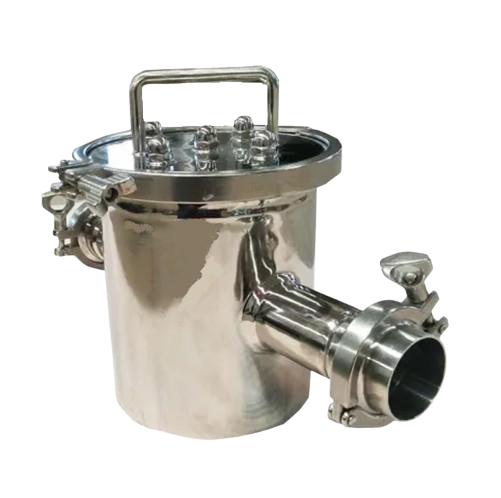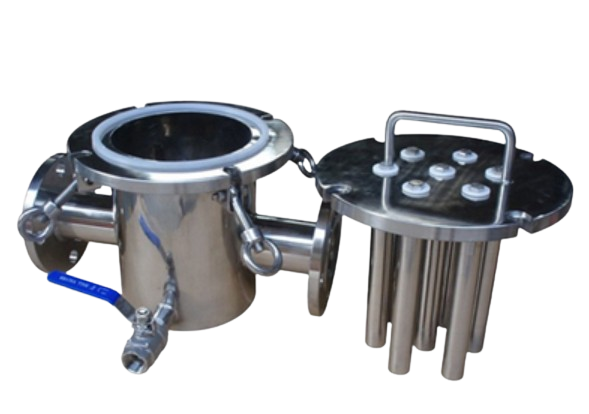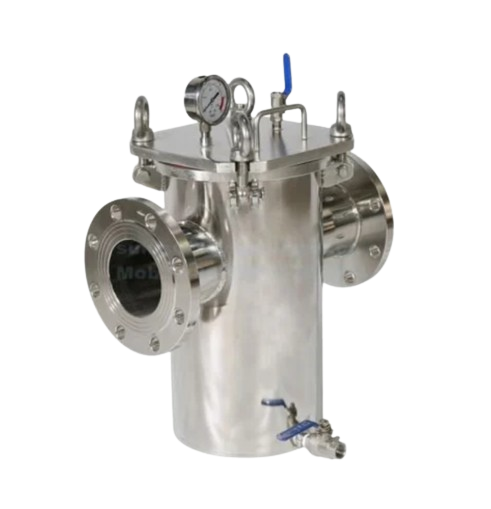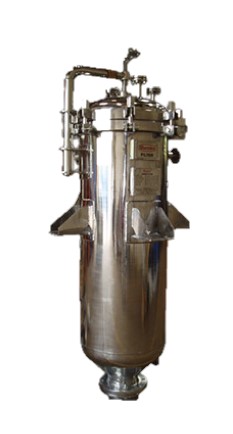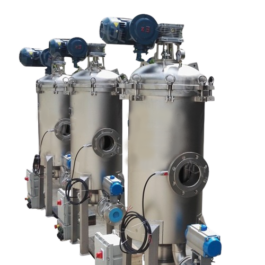Description
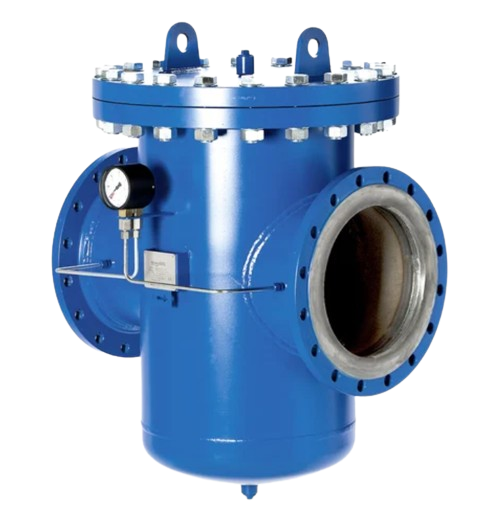 Magnetic Filtration Basket Strainer is a method used to remove ferrous particles and other magnetic contaminants from fluids, primarily in industrial settings. This technology leverages the magnetic properties of certain materials to capture and hold contaminants, thereby improving fluid purity and protecting downstream equipment from damage and wear. The principle behind Magnetic Filtration Basket Strainer is based on the fact that magnetic particles can be attracted to and held by magnetic fields, which can be generated by permanent magnets or electromagnets within the filter.
Magnetic Filtration Basket Strainer is a method used to remove ferrous particles and other magnetic contaminants from fluids, primarily in industrial settings. This technology leverages the magnetic properties of certain materials to capture and hold contaminants, thereby improving fluid purity and protecting downstream equipment from damage and wear. The principle behind Magnetic Filtration Basket Strainer is based on the fact that magnetic particles can be attracted to and held by magnetic fields, which can be generated by permanent magnets or electromagnets within the filter.
The structure of a Magnetic Filtration Basket Strainer typically involves a series of magnetic rods or plates arranged in such a way that the fluid flows around or through them. As the fluid passes by these magnets, the magnetic surface draws in any ferrous particles in the fluid and holds them there, effectively removing them from the fluid stream. This process continues until the magnetic rods or plates are saturated with contaminants, at which point they need to be cleaned or replaced.
The Features
One of the primary advantages of the Magnetic Filtration Basket Strainer is that it can capture very fine particles that conventional filters might miss. Traditional filtration methods, such as mesh or paper filters, rely on physical barriers to trap particles, which can be less effective at capturing smaller contaminants. Magnetic Filtration Basket Strainers, on the other hand, can attract and hold particles as small as a few microns in diameter, making them highly effective for applications where fluid cleanliness is critical.
Another significant benefit of magnetic filtration is its efficiency and low maintenance requirements. Because the magnetic fields continuously attract and hold contaminants, there is no need for frequent replacement of filter elements, as is often the case with traditional filters. Instead, magnetic filters can be cleaned periodically to remove the accumulated particles, which can then be disposed of or recycled. This cleaning process is usually straightforward, involving the removal of the magnetic rods or plates and wiping or rinsing them clean. Some advanced systems even have automatic cleaning mechanisms that further reduce the need for manual intervention.
Reliability and Downtime
Magnetic filtration is particularly advantageous in environments where high reliability and minimal downtime are essential. For example, in hydraulic systems, the presence of ferrous particles can cause significant damage. Furthermore, damaging to pumps, valves, and other components, leading to costly repairs and system downtime. By incorporating magnetic filters, these systems can maintain higher levels of fluid cleanliness, thereby extending the lifespan of critical components and reducing maintenance costs.
The use of magnetic filtration is also prevalent in the manufacturing sector, particularly in processes involving cutting, grinding, and machining. These operations generate a significant number of metallic debris, which can contaminate the coolant and lubricants used in the machinery. Magnetic filters can efficiently remove these particles, ensuring that the fluids remain clean and effective. Thereby improving the quality of the finished products and extending the service life of the machinery.
In addition to its practical advantages, magnetic filtration is also environmentally friendly. Traditional filters, such as paper or synthetic media, often need to be disposed of after use. This disposal contributes to waste and environmental pollution. On the other hand, you can clean and maintain magnetic filters with minimal environmental impact, making them reusable. You can often recycle the captured ferrous particles, further reducing waste and promoting sustainable practices.
Limitations
However, magnetic filtration is not without its limitations. The primary constraint is that it is only effective for ferrous and some other magnetic particles. Magnetic filters will not capture non-magnetic contaminants, such as certain metals, plastics, and organic matter. You will need additional filtration methods to effectively remove these contaminants. This means that in applications with a wide range of contaminants, you may need to use magnetic filtration along with other types of filters. As a result, to achieve the desired level of cleanliness.
Furthermore, the strength and configuration of the magnetic field are critical factors that influence the effectiveness of magnetic filtration. The magnetic field must be strong enough to attract and hold the particles. Furthermore, it may require the use of powerful magnets or electromagnets. The design of the filter also plays a crucial role, as the fluid must flow in such a way. This way it maximizes contact with the magnetic surface. Poor design or inadequate magnetic strength can result in suboptimal filtration performance.
Magnetism
Despite these challenges, advancements in magnetic filtration technology continue to improve its efficiency and applicability. For instance, the development of high-intensity rare-earth magnets has significantly enhanced the ability of magnetic filters to capture fine particles. Additionally, innovations in filter design and fluid dynamics are optimizing the flow patterns. This ensures maximum exposure to the magnetic field. As a result, it improves the overall effectiveness of the filtration process.
In conclusion, magnetic filtration is a powerful and efficient method for removing ferrous particles. They also remove other magnetic contaminants from fluids in various industrial applications. Its ability to capture fine particles, coupled with low maintenance requirements and environmental benefits. Also, it makes it an attractive option for maintaining fluid cleanliness and protecting equipment. While it has its limitations, particularly concerning non-magnetic contaminants, ongoing technological advancements are continually expanding its capabilities and effectiveness. As industries continue to prioritize efficiency, reliability, and sustainability, magnetic filtration is likely to play an increasingly important role. The important role is in fluid management and filtration systems.
Specification
- Compatible with all heating systems
- Easy to maintain
- Clean in minutes with two easy methods
- Automatic air vent (releases trapped air maintaining heating efficiency)
- Rare Earth Neodymium Magnets (9,000 Gauss)
- Full flow filter
- Fits on to horizontal or vertical pipework
- Small physical profile for easy integration
- All valves and fittings included
- Temperature: 41º to 302ºF / 5º to 150ºC
- Full-flange gaskets for robust sealing at high temperatures
- Operating pressure is +/- 174psi / 12 bar
- Large collection reservoir
Installation
Preparation
Review Manufacturer’s Instructions: Carefully read the installation manual provided by the manufacturer to understand specific requirements and recommendations.
Gather Tools and Equipment: Ensure you have all necessary tools and equipment, including wrenches, pipe cutters, sealant, and any mounting hardware provided with the strainer.
Safety Measures: Wear appropriate personal protective equipment (PPE) such as gloves, safety glasses, and protective clothing. Ensure the system is depressurized and drained before starting the installation.
Installation Site Preparation
Location Selection: Choose an appropriate location for the strainer, typically on the return circuit near the boiler or a critical point where fluid re-enters the system. Ensure there is adequate space for installation and maintenance.
Pipe Cutting: Measure and mark the section of pipe where the strainer will be installed. Cut the pipe cleanly and remove any burrs or debris to ensure a proper fit.
Installing the Strainer
Position the Strainer: Position the strainer in the intended location, ensuring that the inlet and outlet align with the existing piping. The magnetic rods should be accessible for maintenance.
Connect the Inlet Pipe: Apply pipe sealant or thread tape to the threads of the inlet pipe. Connect the inlet pipe to the strainer’s inlet port, ensuring a secure and leak-free connection.
Connect the Outlet Pipe: Repeat the same process for the outlet pipe, ensuring it is securely connected to the strainer’s outlet port.
Secure the Strainer: If the strainer has mounting brackets or supports, secure it to a solid surface or frame to prevent movement and vibration during operation.
Final Checks and Testing
Inspect Connections: Check all connections for tightness and ensure there are no leaks. Tighten any fittings as necessary.
System Refill: Gradually refill the system with fluid, checking for any leaks around the strainer and connections. Ensure the system is properly vented to remove any air pockets.
Pressure Test: Slowly pressurize the system and inspect the strainer and connections for leaks under pressure. Address any leaks immediately by tightening fittings or applying additional sealant.
Initial Operation
Start the System: Start the fluid system and monitor the operation of the magnetic filtration basket strainer. Ensure that fluid is flowing smoothly and that the strainer is effectively capturing contaminants.
Initial Cleaning: After a short period of operation, perform an initial cleaning of the strainer to remove any captured debris. This helps to establish a baseline for maintenance intervals.
Maintenance and Documentation
Document Installation: Record the installation details, including the location of the strainer, date of installation, and any observations during the initial operation.
Set Maintenance Schedule: Establish a regular maintenance schedule based on the manufacturer’s recommendations and the observed performance of the strainer. This includes periodic inspections, cleaning, and replacement of magnetic rods if necessary.
By following these detailed installation procedures, you can ensure that the magnetic filtration basket strainer is correctly installed and operates effectively, providing optimal protection for your fluid system.
Maintenance
Regular Inspections
Safety First: Ensure the system is depressurized and fluid flow is stopped before beginning any maintenance. Wear appropriate personal protective equipment (PPE) such as gloves, safety glasses, and protective clothing.
Visual Inspection: Perform a visual inspection of the strainer housing, connections, and surrounding areas. Look for signs of leaks, corrosion, or damage.
Check Pressure Gauges: Verify the pressure differential across the strainer. A significant increase in pressure drop indicates the need for cleaning.
Cleaning the Strainer
Depressurize and Drain: Safely depressurize the system and drain the fluid from the strainer housing to prevent spills and ensure safe access.
Remove Strainer Housing: Carefully open the strainer housing according to the manufacturer’s instructions. This usually involves loosening bolts or clamps that secure the housing.
Extract Magnetic Rods: Remove the magnetic rods from the strainer. Be cautious, as they will have accumulated ferrous particles.
Clean Magnetic Rods: Wipe down the magnetic rods with a clean cloth to remove collected particles. If necessary, use a soft brush to remove stubborn debris. Inspect the rods for signs of wear or damage and replace if necessary.
Clean Strainer Basket: Remove the strainer basket and clean it thoroughly. Rinse it with water or use compressed air to remove non-magnetic contaminants. Ensure all particles are removed to maintain optimal filtration efficiency.
Inspect Seals and Gaskets: Check the seals and gaskets for wear or damage. Replace any that are worn or compromised to prevent leaks during operation.
Reassemble and Test
Reassemble the Strainer: Carefully reinsert the clean magnetic rods and strainer basket into the housing. Ensure all components are properly seated and aligned.
Secure Housing: Close and secure the strainer housing, making sure all bolts or clamps are tightened evenly to prevent leaks.
Refill and Pressurize: Gradually refill the system with fluid, checking for leaks around the strainer housing and connections. Slowly repressurize the system while monitoring for any signs of leakage.
Function Test: Start the system and observe the strainer’s performance. Ensure that fluid flows smoothly and there are no unusual noises or vibrations. Verify that the pressure differential returns to normal levels after cleaning.
Periodic Maintenance
Schedule Regular Cleaning: Based on system usage and contamination levels, establish a regular cleaning schedule. More frequent cleaning may be required in systems with high levels of contaminants.
Replace Worn Components: Periodically inspect and replace magnetic rods, seals, gaskets, and other components that are subject to wear. Follow the manufacturer’s recommendations for replacement intervals.
Record Maintenance Activities: Keep detailed records of all maintenance activities, including dates, actions taken, and any observations. This helps track the strainer’s performance and identify any recurring issues.
Advanced Maintenance
Magnet Strength Check: Periodically check the strength of the magnetic rods to ensure they are still effective at capturing ferrous particles. Replace any rods that have lost significant magnetic strength.
System Flush: Occasionally perform a full system flush to remove any accumulated contaminants that may not be captured by the strainer alone. This helps maintain overall system cleanliness and efficiency.
Consult Manufacturer: If you encounter persistent issues or need specialized maintenance, consult the manufacturer for guidance. They may provide additional maintenance procedures or recommend specific replacement parts.
By following these comprehensive maintenance procedures, you can ensure that the magnetic filtration basket strainer continues to operate efficiently, providing optimal protection for your fluid system and extending the life of your equipment.
Q&A
Q1: What is a magnetic filtration basket strainer?
A1: A magnetic filtration basket strainer is a device used in fluid systems to remove ferrous particles and other contaminants from liquids. It uses powerful magnets to attract and hold magnetic debris, ensuring cleaner fluid and protecting downstream equipment.
Q2: How does a magnetic filtration basket strainer work?
A2: The strainer contains magnetic rods or plates that create a magnetic field. As fluid flows through the strainer, ferrous particles are attracted to and captured by the magnetic rods. The basket strainer also collects non-magnetic debris, which can then be removed during maintenance.
Q3: What types of systems can benefit from using a magnetic filtration basket strainer?
A3: Systems such as hydronic heating, HVAC, industrial boilers, water treatment plants, manufacturing processes, oil and gas operations, food and beverage production, pulp and paper, chemical processing, and pharmaceutical manufacturing can benefit from using a magnetic filtration basket strainer.
Q4: How often should the magnetic filtration basket strainer be cleaned?
A4: The cleaning frequency depends on the system’s usage and the level of contaminants present. Regular inspections and monitoring of pressure differentials can help determine when cleaning is necessary. Typically, a schedule based on the manufacturer’s recommendations should be followed.
Q5: What are the advantages of using a magnetic filtration basket strainer?
A5: The main advantages include efficient removal of ferrous particles, extended equipment life, reduced maintenance costs, improved system performance, and environmentally friendly operation due to reusable filter elements and reduced waste.
Q6: Can magnetic filtration basket strainers capture non-magnetic particles?
A6: While magnetic filtration basket strainers are highly effective at capturing ferrous particles, they can also collect non-magnetic debris in the basket. However, for comprehensive filtration of all types of contaminants, additional filtration methods may be required.
Q7: Where should a magnetic filtration basket strainer be installed in a system?
A7: The strainer should typically be installed on the return circuit near the boiler or at a critical point where fluid re-enters the system. In larger systems, additional units can be installed at various points to provide extra protection for radiators and piping.
Q8: What maintenance is required for a magnetic filtration basket strainer?
A8: Maintenance includes regular inspections, cleaning of magnetic rods and the strainer basket, checking and replacing seals and gaskets, and ensuring all connections are secure. Periodic checks of magnet strength and occasional system flushes are also recommended.
Q9: What are the environmental benefits of using a magnetic filtration basket strainer?
A9: The environmental benefits include reduced waste due to reusable filter elements, the ability to recycle captured ferrous particles, and less frequent replacement of traditional filter media, contributing to more sustainable industrial practices.
Q10: How do I know if the magnetic filtration basket strainer is working effectively?
A10: Effective operation is indicated by a consistent low-pressure differential across the strainer, clean fluid output, and the absence of ferrous particles in downstream equipment. Regular monitoring and maintenance help ensure the strainer continues to function optimally.
Advantages / Disadvantages
Advantages:
Efficient Particle Removal: Magnetic filtration basket strainers are highly effective at capturing ferrous particles, even those as small as a few microns, ensuring high levels of fluid cleanliness.
Extended Equipment Life: By removing harmful contaminants from the fluid, these strainers help protect pumps, valves, and other components, thus extending the lifespan of the equipment.
Low Maintenance: Magnetic strainers require less frequent maintenance compared to traditional filters. The magnetic rods can be easily cleaned and reused, reducing downtime and maintenance costs.
Cost-Effective: Over time, the reduced need for replacement parts and the protection of expensive equipment can result in significant cost savings.
Environmentally Friendly: The reusable nature of magnetic rods and the ability to recycle captured ferrous particles make magnetic filtration an eco-friendly option, reducing waste and promoting sustainability.
Versatile Application: These strainers can be used in a wide range of industries and applications, from hydronic heating systems to industrial manufacturing processes.
Improved System Performance: By maintaining cleaner fluids, magnetic strainers help improve the overall efficiency and performance of fluid systems.
Non-Intrusive Installation: Magnetic filtration systems are often designed for easy integration into existing pipelines without the need for significant modifications.
Reduced Pressure Drop: Properly designed magnetic filters can maintain a low pressure drop, ensuring smooth fluid flow and efficient operation.
Enhanced Reliability: The consistent removal of contaminants helps ensure the reliable operation of fluid systems, minimizing the risk of unexpected failures and downtime.
Disadvantages:
Limited to Magnetic Particles: Magnetic filtration is only effective for ferrous and some other magnetic particles. Non-magnetic contaminants, such as certain metals, plastics, and organic matter, will not be captured and may require additional filtration methods.
Initial Cost: The initial investment in magnetic filtration systems can be higher than traditional filters, potentially making it less attractive for some budget-conscious operations.
Regular Cleaning Required: Although less frequent than traditional filters, magnetic strainers still require regular cleaning to maintain their effectiveness, which involves manual labor or automated systems.
Magnet Strength Degradation: Over time, the strength of the magnetic rods can degrade, reducing their effectiveness. Periodic checks and replacements are necessary to ensure optimal performance.
Space Requirements: Depending on the design and size of the strainer, adequate space is needed for installation and maintenance, which may be a constraint in some setups.
Potential for Magnet Damage: Magnetic rods can be susceptible to damage from impact or extreme conditions, necessitating careful handling and potential replacement.
Complexity for Non-Magnetic Contaminants: In systems with a mix of magnetic and non-magnetic contaminants, a combination of filtration methods may be required, adding to system complexity and cost.
Dependency on Proper Installation: The effectiveness of the magnetic strainer is heavily dependent on proper installation. Incorrect placement or orientation can significantly reduce its filtration efficiency.
Flow Rate Limitations: Some magnetic filtration systems may impose limitations on flow rates, which can be a drawback in high-flow applications.
Monitoring and Maintenance Knowledge: Effective use of magnetic filtration requires knowledge of monitoring and maintenance procedures to ensure consistent performance, which may necessitate additional training for personnel.
Applications
Magnetic strainers are versatile devices used in various applications to enhance fluid purity by removing ferrous particles and other contaminants. Here are some key applications:
Hydronic Heating Systems:
- Magnetic strainers are used in hydronic heating systems to capture magnetite and other debris from the water, improving system efficiency and extending the lifespan of boilers, pumps, and radiators.
Commercial and Industrial Boilers:
- In commercial and industrial settings, magnetic strainers protect boilers by removing ferrous particles that can cause wear and damage, ensuring smooth and reliable operation.
HVAC Systems:
- Magnetic strainers are employed in heating, ventilation, and air conditioning (HVAC) systems to maintain clean fluid circuits, reduce maintenance, and enhance the performance of pumps and valves.
Water Treatment Plants:
- They are used in water treatment facilities to remove magnetic contaminants from water and ensure the cleanliness and quality of the treated water.
Manufacturing Processes:
- In manufacturing, magnetic strainers protect equipment used in processes such as cooling, lubrication, and chemical mixing by removing metal debris that can cause damage or contamination.
Oil and Gas Industry:
- Magnetic strainers are utilized in oil and gas operations to filter out ferrous particles from drilling fluids, pipelines, and other critical systems, ensuring operational efficiency and preventing equipment damage.
Food and Beverage Industry:
- They are used in food and beverage processing to ensure that fluids used in production are free of metal contaminants, maintaining product quality and compliance with safety standards.
Pulp and Paper Industry:
- Magnetic strainers help remove ferrous particles from process water and other fluids in the pulp and paper industry, preventing damage to machinery and improving the quality of the final product.
Chemical Processing:
- In chemical processing plants, magnetic strainers capture metal contaminants from various chemical solutions and slurries, protecting equipment and ensuring product purity.
Pharmaceutical Industry:
- They are employed in pharmaceutical manufacturing to ensure that fluids used in the production process are free of magnetic contaminants, which is crucial for maintaining product quality and regulatory compliance.
By integrating magnetic strainers into these applications, industries can achieve improved fluid cleanliness, protect valuable equipment, and enhance overall system performance.
Downloads
Drawings
 Magnetic Filtration Basket Strainer is a method used to remove ferrous particles and other magnetic contaminants from fluids, primarily in industrial settings. This technology leverages the magnetic properties of certain materials to capture and hold contaminants, thereby improving fluid purity and protecting downstream equipment from damage and wear. The principle behind Magnetic Filtration Basket Strainer is based on the fact that magnetic particles can be attracted to and held by magnetic fields, which can be generated by permanent magnets or electromagnets within the filter.
Magnetic Filtration Basket Strainer is a method used to remove ferrous particles and other magnetic contaminants from fluids, primarily in industrial settings. This technology leverages the magnetic properties of certain materials to capture and hold contaminants, thereby improving fluid purity and protecting downstream equipment from damage and wear. The principle behind Magnetic Filtration Basket Strainer is based on the fact that magnetic particles can be attracted to and held by magnetic fields, which can be generated by permanent magnets or electromagnets within the filter.
